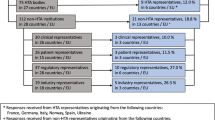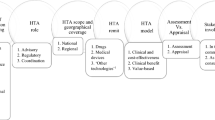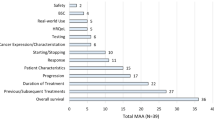Abstract
The concept of access with evidence development (AED), also known as ‘coverage with evidence development’ in the Medicare programme, has long been discussed as a policy option for ensuring more appropriate use of new technologies in the US. This article provides a comprehensive overview of more than 10 years of US experience with AED, both in the public and private healthcare sectors. Beginning with a discussion of the successes of private plans conditional coverage for high-density chemotherapy for autologous bone marrow transplants for metastatic breast cancer and Medicare’s conditional coverage of lung-volume-reduction surgery in the 1990s, the article moves on to describe how Medicare worked to codify AED as one of its coverage policy options in the early part of this decade. More recent private and public sector initiatives are also discussed, including an overview of barriers to implementing AED. Despite the complexity of political, financial and ethical issues faced in implementation, AED is now a permanent fixture of US coverage policy. Future initiatives within the Medicare programme and with private payers in the US are much more likely to succeed by relying upon the simple but consequential principles laid out at a Summit convened in Banff, Alberta, Canada in 2009 and presented in another article in this issue.

Similar content being viewed by others
References
Kary W, Bergthold L, Talbott M, et al. Coverage for evidence development: a conceptual framework. Baltimore (MD): Center for Medical Technology Policy, 2009 Jan
Tunis SR, Pearson SD. Coverage options for promising technologies: Medicare’s ‘Coverage with Evidence Development’. Health Aff 2006 Sep/Oct; 25 (5): pp1218-30
Carino T, Sheingold S, Tunis SR. Using clinical trials as a condition of coverage: lessons learned from the National Emphysema Treatment Trial. Clin Trials 2004 Feb; 1 (1): 108–14
Mello M, Brennan TA. The controversy over high-dose chemotherapy with autologous bone marrow transplant for breast cancer. Health Aff 2001 Sep/Oct; 20 (5): 101–17
Rettig R, Jacobson P, Farquhar CM, et al. False hope: bone marrow transplantation for breast cancer. New York: Oxford University Press, 2007
Ramsey SD, Sullivan SD. Evidence, economics, and emphysema: Medicares long journey with lung volume reduction surgery. A case of science meeting politics. Health Aff 2005 Jan/Feb; 24 (1): 55–66
Atkins D, Siegel J, Slutsky J. Making policy when evidence is in dispute. Health Aff 2005 Jan/Feb; 24 (1): 102–13
Eddy DM. High-dose chemotherapy with autologous bone marrow transplantation for treatment of metastatic breast cancer. J Clin Oncology 1992; 10: 657–70
McGivney W. Autologous bone marrow transplantation: a microcosm of the US health care system. In: Gelijns A, Dawkins H, editors. Adopting new medical technology. Washington, DC: National Academy Press, 1994: 109–16
Stadtmauer EA, O’Neill A, Goldstein LJ, et al. Conventionaldose chemotherapy compared with high-dose chemotherapy plus autologous hematopoietic stem-cell transplantation for metastatic breast cancer. N Engl J Med 2000 Apr; 342 (15): 1069–76
Peters WP, Rosner GL, Vredenburgh JJ, et al. Prospective, randomized comparison of high-dose chemotherapy with stem-cell support versus intermediate-dose chemotherapy after surgery and adjuvant chemotherapy in women with high-risk primary breast cancer: a report of CALGB 9082, SWOG 9114, and NCIC MA-13. J Clin Oncol 2005 Apr 1; 23 (10): 2191–200
Tallman MS, Gray R, Robert NJ, et al. Conventional adjuvant chemotherapy with or without high-dose chemotherapy and autologous stem-cell transplantation in high-risk breast cancer. N Engl J Med 2003 Jul 3; 349 (1): 17–26
Fishman A, Martinez F, Naunheim K, et al. A randomized trial comparing lung-volume-reduction surgery with medical therapy for severe emphysema. N Engl J Med 2003 May; 348 (21): 2059–73
Goodman C, Hsiao J. Medical Technology Leadership Forum Summit: conditional coverage of investigational technologies. Washington, DC: The Medical Technology Leadership Forum, 1999 Oct
Newcomer LN. Managing coverage for clinical trials. Eff Clin Pract 1996 Sept/Oct; 2 (9): 244–6
Centers for Medicare and Medicaid Services. Coverage with evidence development [online]. Available from URL: http://www.cms.hhs.gov/CoverageGenInfo/03_CED.asp#TopOfPage [Accessed 2009 Jun]
42 USC 1395y: Exclusions from coverage and medicare as secondary payer [online]. Available from URL: http://frwebgate3.access.gpo.gov/cgi-bin/PDFgate.cgi?WAISdocID=4688528467+18+2+0&WAISaction=retrieve [Accessed 2009 Nov 17]
42 USC 1395b1: Incentives for economy while maintaining or improving quality in provision of health services [online]. Available from URL: http://frwebgate5.access.gpo.gov/cgi-bin/PDFgate.cgi?WAISdocID=474535300289+9+2+0amp;WAISaction=retrieve [Accessed 2009 Nov 16]
Centers for Medicare and Medicaid Services. Guidance for the public, industry, and CMS staff: national coverage determinations with data collection as a condition of coverage. Coverage with evidence development. 2006 Jul [online]. Available from URL: http://www.cms.hhs.gov/mcd/ncpc_view_document.asp?id=8/ [Accessed 2009 Jun 4]
42 USC 1395y(a)(1)(E): Exclusions from coverage andmedicare as secondary payer [online]. Available from URL: http://frwebgate3.access.gpo.gov/cgi-bin/PDFgate.cgi?WAISdocID=4688528467+18+2+0amp;WAISaction=retrieve [Accessed 2009 Nov 17]
42 USC 1320b12: Research on outcomes of health care services and procedures [online]. Available from URL: http://frwebgate3.access.gpo.gov/cgi-bin/PDFgate.cgi?WAISdocID=4688528467+18+2+0amp;WAISaction=retrieve [Accessed 2009 Nov 16]
Centers for Medicare and Medicaid Services. NCD for routine costs in clinical trials (310.1). 2007 Jul [online] Available from URL: http://www.cms.hhs.gov/mcd/viewncd.asp?ncd_id=310.1amp;ncd_version=2&basket=ncd%3A310%2E1%3A2%3ARoutine+Costs+in+Clinical+Trials/ [Accessed 2009 Jun 4]
Aronson N. A third path: opportunities and obstacles [presentation to National Business Group on Health National Committee for Evidence Based Benefit Design]. Washington, DC: Blue cross and Blue Shield Association, 2008 Jul 15
Turner JA, Hollingsworth W, Comstock BA, et al. Spinal cord stimulators (SCS) for injured workers with chronic back and leg pain after lumbar surgery: a prospective study to describe the costs, complications, and patient outcomes. Final report [funded by contract K311 from the State of Washington State Department of Labor & Industries]. Seattle (WA): University of Washington, 2008 Sept 20
Turner JA, Hollingworth W, Comstock BA, et al. Spinal cord stimulation for failed back surgery syndrome outcomes in a workers compensation setting. Pain. Epub 2009 Oct
Sharyl J, Nass SJ, Moses HL, editors. Cancer biomarkers: the promises and challenges of improving detection and treatment. Washington, DC: National Academies Press, 2007
Secretary’s Advisory Committee on Genetics in Health and Society. US system of oversight of genetic testing: a response to the charge of the Secretary of Health and Human Services. Washington, DC: Department of Health and Human Services, 2008 Apr [online]. Available from URL: http://oba.od.nih.gov/oba/SACGHS/reports/SACGHS_PGx_report.pdf [Accessed 2009 Nov 17]
Khoury MJ, Berg A, Coates R, et al. The evidence dilemma in genomic medicine. Health Aff 2008 Nov/Dec; 27 (6): 1600–11
Pollack A. Pricing pills by the results. New York Times 2007 Jul 14 [online]. Available from URL: http://www.nytimes.com/2007/07/14/business/14drugprice.html?_r=1&pagewanted=print&oref=slogin/ [Accessed 2009 Jun 11]
Centers for Medicare and Medicaid Services. Proposed decision memo for pharmacogenomic testing for warfarin response (CAG-00400N). 2009 May [online]. Available from URL: http://www.cms.hhs.gov/mcd/viewdraftdecisionmemo.asp?id=224/ [Accessed 2009 Jun 4]
Pearson SD, Miller FG, Emanuel EJ. Medicare’s requirement for research participation as a condition of coverage: is it ethical? J Am Med Assoc 2006 Aug; 296 (8): 988–91
Center for Medical Technology Policy. Criteria for topic selection [online]. Available from URL: http://www.cmtpnet.org/get-involved-1/criteria-for-topic-selection/ [Accessed 2009 Jun 16]
Briggs A, Ritchie K, Fenwick E, et al. Access with evidence development in the UK: past experience, current initiatives and future potential. Pharmacoeconomics 2010; 28 (2): 163–70
Centers for Medicare and Medicaid Services. Medicare expands coverage of PET scans as diagnostic tool: CMS’ coverage with evidence development project shows PET scans as ‘reasonable and necessary’ for initial treatment decisions of most solid tumor cancers. 2009 Apr 6 [press release; online]. Available from URL: http://www.cms.hhs.gov/apps/media/press/release.asp?Counter=3436&intNumPerPage=10amp;checkDate=amp;checkKey=amp;srchType=1amp;numDays=3500amp;srchOpt=0amp;srchData=amp;keywordType=Allamp;chkNewsType=1%2C+2%2C+3%2C+4%2C+5amp;intPage=amp;showAll=amp;pYear=amp;year=am[;desc=amp;cboOrder=date [Accessed2009 Jun 4]
Menon D, McCabe CJ, Stafinski T, et al. Principles of designof access with evidence development approaches:a consensus statement from the Banff summit. Pharmacoeconomics 2010; 28 (2): 109–11
Acknowledgements
No sources of funding were used to assist in the preparation of this article.
Penny Mohr and Sean Tunis have received grant support for policy development concerning coverage with evidence development. Dr Tunis also helped implement the CED programme in the US Medicare system. The authors have no other conflicts of interest that are directly relevant to the content of this article.
The authors thank Linda Bergthold, Wade Aubry and Seema Sonnad for their helpful comments on an earlier draft of this manuscript. All remaining errors or omissions are solely the responsibility of the authors.
Author information
Authors and Affiliations
Corresponding author
Rights and permissions
About this article
Cite this article
Mohr, P.E., Tunis, S.R. Access with Evidence Development. Pharmacoeconomics 28, 153–162 (2010). https://doi.org/10.2165/11531050-000000000-00000
Published:
Issue Date:
DOI: https://doi.org/10.2165/11531050-000000000-00000




